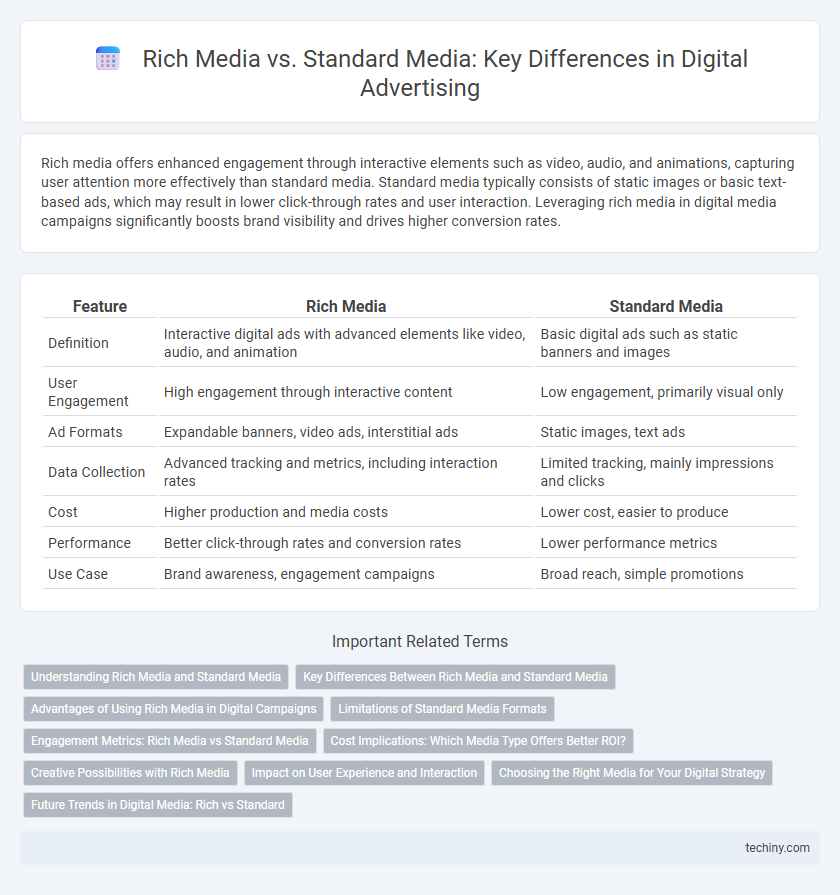Rich media offers enhanced engagement through interactive elements such as video, audio, and animations, capturing user attention more effectively than standard media. Standard media typically consists of static images or basic text-based ads, which may result in lower click-through rates and user interaction. Leveraging rich media in digital media campaigns significantly boosts brand visibility and drives higher conversion rates.
Table of Comparison
| Feature | Rich Media | Standard Media |
|---|---|---|
| Definition | Interactive digital ads with advanced elements like video, audio, and animation | Basic digital ads such as static banners and images |
| User Engagement | High engagement through interactive content | Low engagement, primarily visual only |
| Ad Formats | Expandable banners, video ads, interstitial ads | Static images, text ads |
| Data Collection | Advanced tracking and metrics, including interaction rates | Limited tracking, mainly impressions and clicks |
| Cost | Higher production and media costs | Lower cost, easier to produce |
| Performance | Better click-through rates and conversion rates | Lower performance metrics |
| Use Case | Brand awareness, engagement campaigns | Broad reach, simple promotions |
Understanding Rich Media and Standard Media
Rich media ads incorporate interactive elements such as video, audio, and clickable features, enhancing user engagement and delivering a more immersive experience. Standard media, typically comprising static images or simple banner ads, offer limited interaction and rely on visual appeal to capture attention. Understanding the differences in format and user interaction helps marketers choose the appropriate media type for their digital campaigns.
Key Differences Between Rich Media and Standard Media
Rich media ads incorporate interactive elements such as video, audio, and animations, enhancing user engagement compared to static standard media ads. Standard media primarily consists of basic formats like banner ads and text, offering limited user interaction and lower engagement rates. Rich media's advanced technologies enable tracking of detailed user interactions, providing more comprehensive analytics than standard media.
Advantages of Using Rich Media in Digital Campaigns
Rich media in digital campaigns significantly enhances user engagement through interactive elements like videos, animations, and clickable content, leading to higher click-through rates and improved brand recall. These dynamic formats provide detailed analytics and real-time data, allowing marketers to optimize campaign performance with precision. Compared to standard media, rich media drives stronger emotional connections by offering immersive experiences that capture audience attention more effectively.
Limitations of Standard Media Formats
Standard media formats often suffer from limited interactivity and static content, which restricts user engagement and reduce overall effectiveness in digital campaigns. These formats lack dynamic elements such as video, audio, and rich animations, leading to lower click-through rates and diminished brand impact. As a result, advertisers encounter challenges in capturing consumer attention and delivering immersive experiences compared to rich media formats.
Engagement Metrics: Rich Media vs Standard Media
Rich Media significantly outperforms Standard Media in engagement metrics, delivering higher click-through rates (CTR) and longer dwell times due to interactive elements like video, audio, and animations. Standard Media, typically static images or text-based ads, often sees lower user interaction and reduced brand recall. Interactive features in Rich Media drive superior engagement, making them essential for campaigns targeting increased user involvement and conversion rates.
Cost Implications: Which Media Type Offers Better ROI?
Rich media campaigns typically demand higher initial investment due to advanced interactive elements and enhanced user engagement features, but they often yield superior ROI through increased click-through rates and longer user interaction times. Standard media, while more affordable and easier to deploy, may result in lower engagement metrics, potentially reducing overall campaign effectiveness and cost efficiency. Advertisers seeking optimal ROI should weigh the upfront costs of rich media against its proven ability to drive deeper brand interaction and conversion rates compared to standard media formats.
Creative Possibilities with Rich Media
Rich Media offers expansive creative possibilities beyond Standard Media through interactive elements such as video, audio, and dynamic graphics that engage users more deeply. These features enable personalized experiences, real-time content updates, and enhanced storytelling techniques that drive higher click-through rates and user retention. Brands leveraging Rich Media benefit from increased consumer engagement, improved ad performance metrics, and greater flexibility in message delivery.
Impact on User Experience and Interaction
Rich media significantly enhances user experience by integrating interactive elements such as videos, animations, and clickable features, leading to higher engagement and longer session durations. Standard media, typically consisting of static images or text, offers limited interaction, resulting in relatively passive user involvement and lower retention rates. The dynamic nature of rich media drives more effective communication and fosters deeper brand-consumer connections compared to standard media formats.
Choosing the Right Media for Your Digital Strategy
Rich media offers interactive elements such as video, audio, and dynamic visuals that significantly enhance user engagement compared to standard media's static content. Selecting the right media depends on campaign goals, target audience behavior, and platform capabilities, with rich media driving higher click-through rates and improved conversion metrics. Analyzing performance data and user interaction patterns helps optimize media choices for maximizing digital strategy effectiveness.
Future Trends in Digital Media: Rich vs Standard
Future trends in digital media emphasize a growing shift towards rich media formats, driven by advancements in augmented reality (AR), virtual reality (VR), and interactive video technologies that enhance user engagement and personalized experiences. Standard media, while still relevant for broad reach and cost-efficiency, is increasingly supplemented by rich media's ability to deliver immersive content and detailed analytics, making it a preferred choice for brands investing in future-proof digital advertising strategies. Enhanced bandwidth and AI-powered content optimization are set to accelerate the adoption of rich media, positioning it as the cornerstone of next-generation digital marketing campaigns.
Rich Media vs Standard Media Infographic

 techiny.com
techiny.com